TELL ME About It: AAC Learning with ‘Go Away, Big Green Monster!’
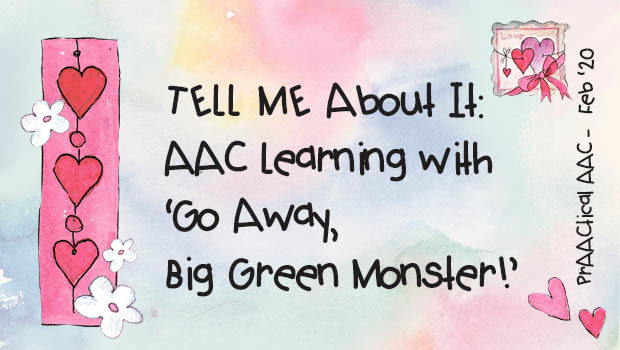
How can we infuse core vocabulary teaching throughout the preschool routine? Today, we welcome back Jeanna Antrim and Maggie Judson for another guest post in the TELL ME About It series. Maggie and Jeanna are SLPs who work in the Assistive Technology Department for the Belleville Area Special Services Cooperative (BASSC) in southern Illinois. They are AT/AAC facilitators and provide evaluations, direct therapy, consultations, and trainings with school teams. In this series, they discuss how they support preschool teachers who are implementing the TELL ME program with their young students.
Today’s post covers ways to promote AAC use while focusing on the book ‘Go Away, Big Green Monster!’ Enjoy their prAACtical suggestions and don’t miss their Lesson Plan, video demonstrations, and other resources at the end of the post.
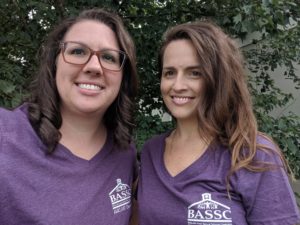
TELL ME About It: AAC Learning with ‘Go Away, Big Green Monster!’
TELL ME About Reading: The sixth book in the TELL ME program (Teaching Early Language and Literacy through Multimodal Expression) is “Go Away, Big Green Monster!”. Such a fun book, with interaction built into each page – as you read, the monster grows bigger and bigger in the die-cut illustrations. And then, as we tell that monster to go away! it gets smaller and smaller until it’s gone. It’s a real page-turner, and we have found that students just can’t wait to see what happens next! Which is great, because you know what happens next? More core words, that’s what! “Go Away, Big Green Monster!” has us targeting the core words AWAY, GO, NOT, STOP throughout the book. The goal? For students to repeatedly hear, be provided with aided language input, and have opportunities to practice saying the core words using natural speech, communication boards, or personal AAC systems!
Book Focus: Go Away, Big Green Monster!
- Core Words (BOW WOW Words): AWAY, GO, NOT, STOP
- Additional Words (Tiger Talk Words): again, big
- Concept Vocabulary: body parts and colors
- Special Letter: p
- Book Concept: reading print from left to right
TELL ME About Writing:
Students with complex communication needs require daily opportunities to write for authentic, meaningful reasons. Tying writing in with an enjoyable shared reading activity is one way to provide that opportunity, as well as create a context for extra core word practice. Having a set of words to focus on during the week helps us give that repeated exposure that students require to learn new vocabulary!
- Before Writing: First, review those core words – AWAY, GO, NOT, STOP – to work in that repeated exposure. Then, review the title of the chart – ‘My Monster’ – pointing to each word as you go.
- Writing: Today’s lesson has you re-reading the entire chart. As you read a sentence, point to each word as you go – you can make it a bit more visual by adding a mark under each word as you read it. During this activity, the other communication partners in the classroom can provide aided language input for the core words you are reading. Then, go on a core word hunt! Hold up the written word or a picture symbol and have students find them in the chart.
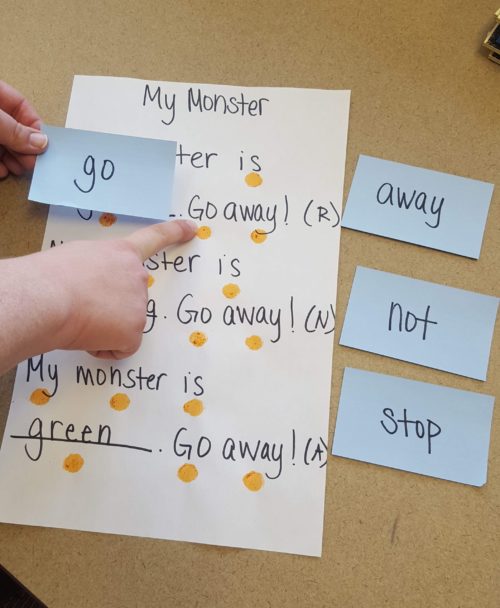
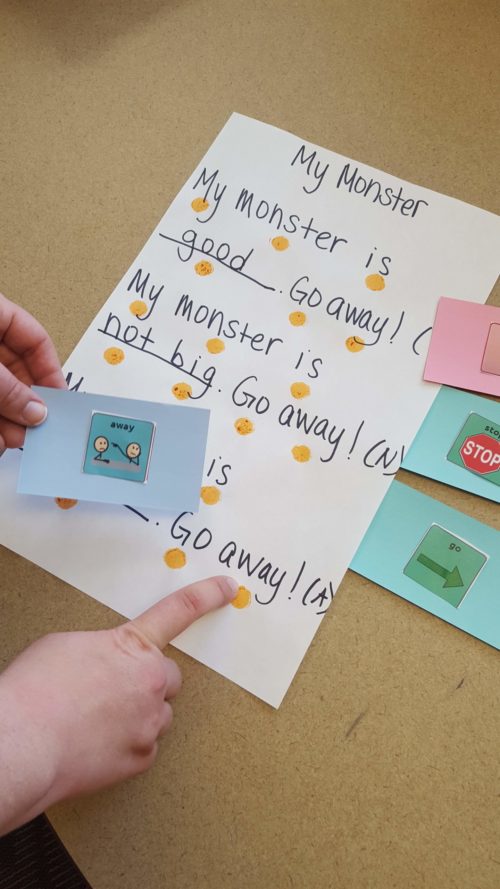
- After Writing: Follow up with activities to work on the special letter ‘p’!
- Sing the letter song
- Find ‘p’ in the chart
- Do a fun craft or two focused on ‘p’, such as a sensory bag on top of the letter ‘p’ so the students can trace it.
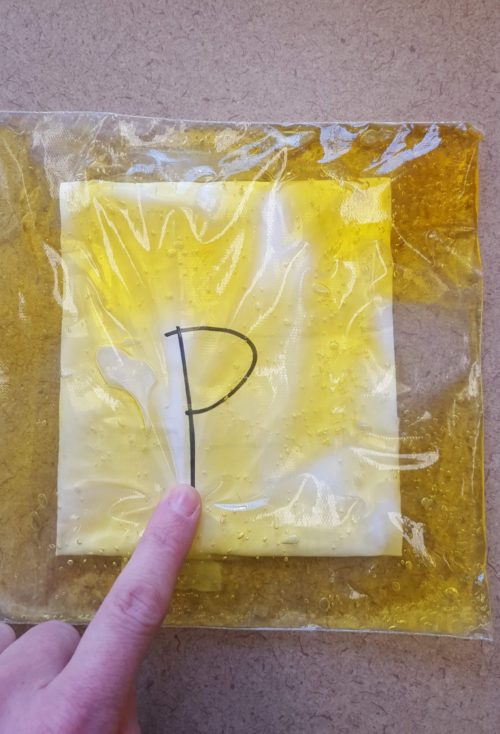
These activities help to work in repeated practice with the letter name and sound.
TELL ME More: Below are some specific ideas on how to implement “Go Away, Big Green Monster!” in your therapy sessions and classrooms TELL ME-style!
- Activity – Quick, Quack Questions!
Well-timed questions can be a great way to generate conversation while working in more core word exposure and giving students practice with book-related concepts. The TELL ME program calls this kind of activity ‘Quick, Quack Questions’. An easy, natural time to work in Quick, Quack Questions is during snack time. In a preschool classroom, snack time is an established, routine part of the day. Which makes it a great time to engage students in this type of activity! Some examples of questions that can be asked are:
- “What are you drinking?”
- “Where do you eat a snack when you are at home?”
- “When do you feel scared?”
- “Who did you play blocks with today?”
Writing the questions and the responses down allows for students to have more opportunities to see their thoughts put into writing. AND it gives you extra teaching materials, as you can review it and build upon it during other instructional times. So this activity is a definite win-win!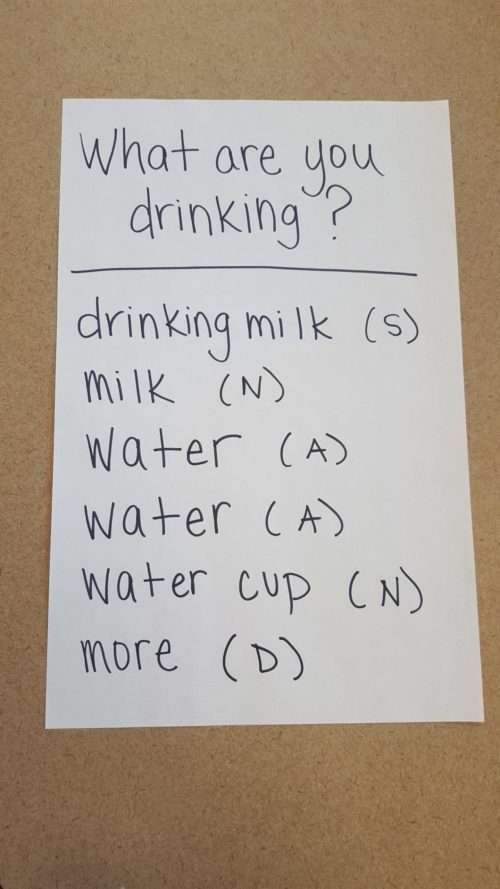
- Teaching Strategy – Descriptive Teaching!
Students with complex communication needs benefit from frequent opportunities to practice and use new vocabulary. Incorporating the target words in numerous instructional activities throughout the day supports this language growth. One way to work in more core word exposure is to use descriptive teaching!
So, what is descriptive teaching? It is an instructional strategy that focuses on using common words (aka core words!) to describe and define topic-specific vocabulary. “Using a descriptive style, the teacher mentions and references the context-specific words, then teaches concepts behind the words using high-frequency, re-usable, common words” (Van Tatenhove 2009). So instead of just using the fringe word ‘monster’, which may not be included in a student’s AAC system, core words can be used to describe a monster.
One way to get some practice in with the instructional strategy of descriptive teaching is to make a character web for the big, green monster. Start with a picture or a drawing of the monster in the center of a piece of paper. Then communication partners lead students in using core words available on the AAC systems to describe the monster. You can say something like, “Who can tell me something about the monster?” and support students to use core words to describe and define it! For example, students can say that the monster is:
- Big
- Green
- Scary
- Spiky hair
- Round eyes
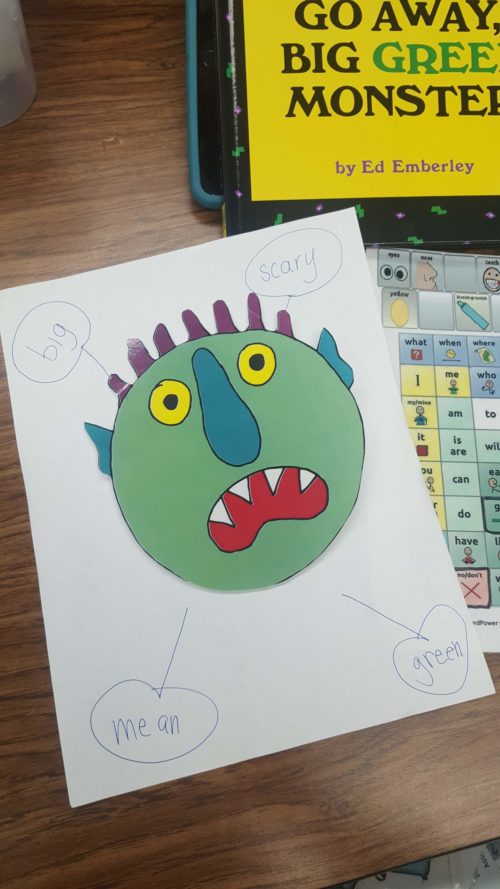 You can see that by using descriptive language vs. only using the fringe word, students are provided with a whole lot of vocabulary exposure!
You can see that by using descriptive language vs. only using the fringe word, students are provided with a whole lot of vocabulary exposure!
- Implementation Tip – Open-ended questions (CROWD and CAR)!
We’ve all been there. You’re in the middle of a shared reading activity, but the students are wiggling around and not paying you much attention. You try and stay focused, but you get flustered. Somewhere in there, you forget what questions you wanted to ask. So you start in on those simple yes/no questions, or you just skip the questions altogether. This has happened to us more than once, and we have learned from our mistakes! To help keep us focused, we write out the questions we want to ask and place them in the book before reading. This keeps us from reverting to those close-ended yes/no questions or skipping over this critical component of shared reading entirely! 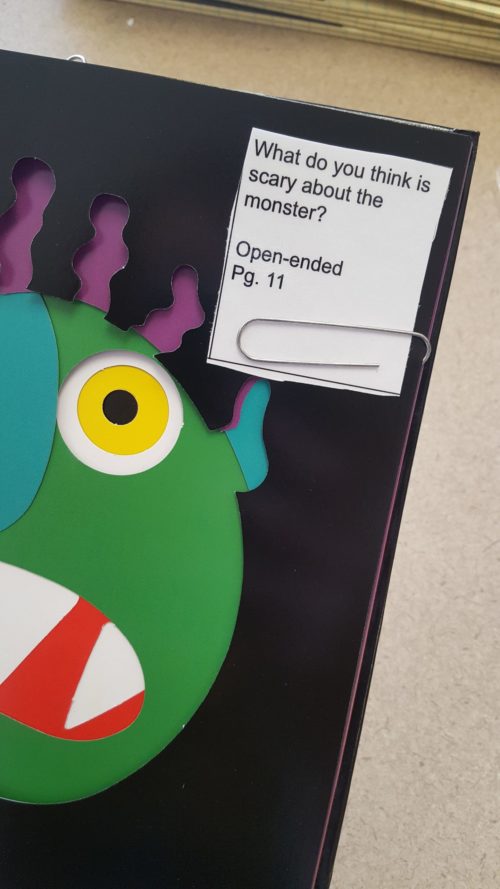
We love using the CAR (Comment – Ask – Respond) strategy during shared reading, so we have prepared “Go Away, Big Green Monster!” with questions to help make it easy to put the CROWD in the CAR. We’re big fans of this strategy as it supports us as communication partners to ask a variety of questions (no yes/no questions here!) during shared reading. Below are some examples of CROWD questions you can ask when reading “Go Away Big, Green Monster!”
- C = Completion – Tell the monster to _____ _______ (go away)!
- R = Recall – Tell me some of other body parts we read about in the story.
- O = Open Ended – I wonder what you think is scary about the monster?
- W = Wh Question – Point to the body parts and ask: What is this?
- D = Distancing – We told the monster to go away. Who else do you tell to go away?
To learn more about CAR and CROWD, check out these modules from sharedreader.org – http://bit.ly/carreadingstrategy and http://bit.ly/crowdstrategy
- Aided Language Input Tip – Self Talk for Finding Words!
So now that you’ve gotten lots of practice providing aided language input on different AAC systems, you may have noticed there are times when you can’t remember where a particular word is located. This happens to us coming back from a long break, after a weekend, on a Wednesday. Hey, it happens! We used to get flustered when we couldn’t find a word, but now we use it as a learning opportunity. We use self-talk to narrate the steps of what we are thinking to find the word:
- “Hmmm, I can’t remember where the word STOP STOP is an action word, so I am going to look in the green words.”
- “AWAY. I don’t know how to say AWAY on the device. Let’s look it up. First, I’ll go to the keyboard. Then I go to ‘word finder’. I type in AWAY, and hit ‘find’. And look! It shows me how I say AWAY!”
This ‘thinking out loud’ provides students a model of the problem-solving that can be used to find and say words!
- Goal Ideas – Providing shared reading and writing opportunities directly relates to IEP goals, as these activities align with various core standards. Here are some examples you may find applicable:
- ELA-Literacy.W.K.5: With guidance and support from adults, respond to questions and suggestions from peers and add details to strengthen writing as needed.
- ELA-Literacy.L.K.1d: Understand and use question words (interrogatives) (e.g., who, what, where, when, why, how).
———————————————————————————————————————
To read more about how we prepare for a TELL ME week, check out our previous posts in the TELL ME About It series!
- What Do You Like?
- Here Are My Hands
- From Head to Toe
- I Went Walking
- Brown Bear, Brown Bear
- TELL ME AAC Literacy Kits
Be sure to check back next month as we work through the TELL ME manual and share activities, teaching strategies and implementation tips for the next book in the program, “No, David!”!
RESOURCES and REFERENCES:
- Van Tatenhove, G. (2009). Building Language Competence with Students Using AAC Devices: Six Challenges. Perspectives on Augmentative and Alternative Communication, 18(2), 38-47.
- CAR and CROWD references – (Notari‐Syverson, Maddox, and Cole, 1999), (Whitehurst et al., 1988)
- You can purchase the TELL ME manual from the Attainment Company or from ASHA.
- You can learn more about the program by watching the webinar TELL ME: AAC for the Preschool Classroom presented by Dr. Carole Zangari, available from Saltillo (bit.ly/2RNpykn).
- You can find our Lesson Planning form for “Go Away, Big Green Monster!” and a blank form here.
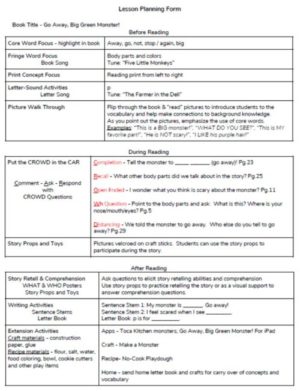
Check out the videos of us reading the book “Go Away, Big Green Monster!” while providing aided language input for the target core words.
Reading Big Green Monster with Touchchat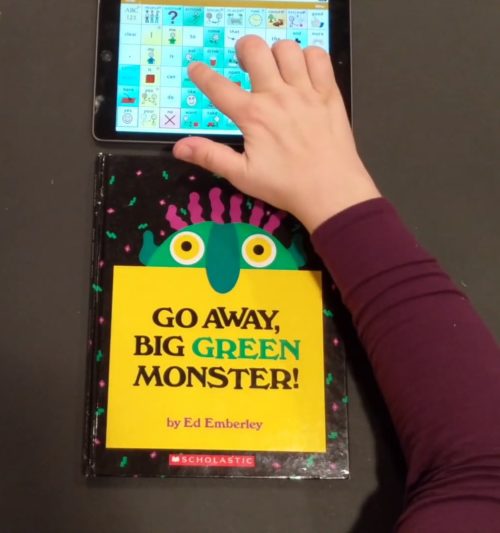
Reading Big Green Monster with Snap Core First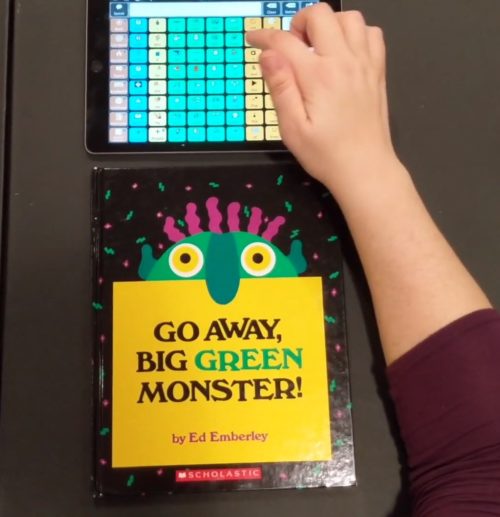
Reading Big Green Monster with LAMP Words For L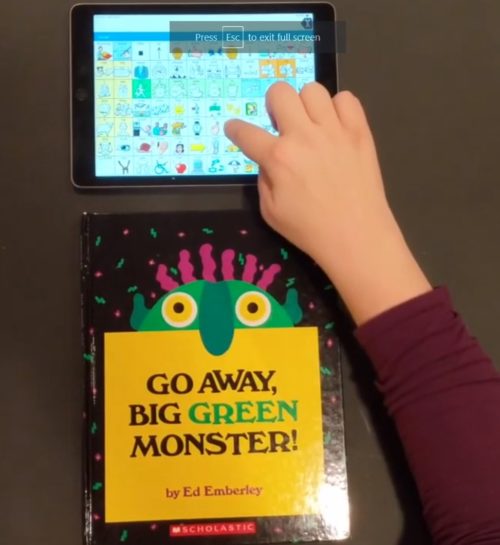
Follow us on Instagram @basscAAC and subscribe to our YouTube channel (basscAAC) for more AAC implementation ideas!
Filed under: Featured Posts, PrAACtical Thinking
Tagged With: preschool, TELL ME
This post was written by Carole Zangari

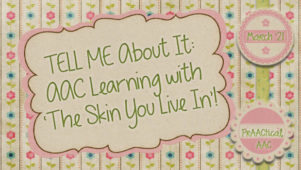
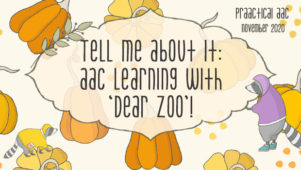
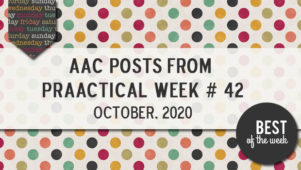
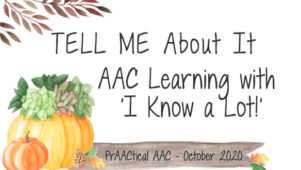
1 Comment